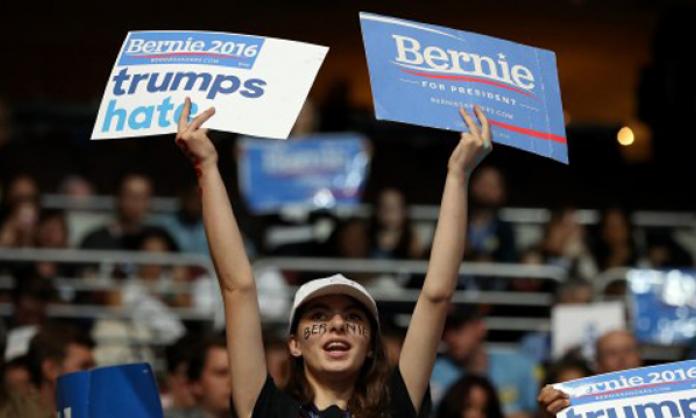It is easy to despair about Donald Trump’s America. The most reactionary president in modern US history has survived more than a year in office and maintains a significant base of support.
Surrounded by a sea of far right and semi-fascist advisers, Trump pumps out vile tweets threatening nuclear war, defending white supremacists, demonising Muslims and Mexicans and denigrating women. He has pushed through the largest corporate tax cut in US history to increase the wealth of the super rich, and has given big business open slather to ravage the environment.
Meanwhile, his supposed opposition, the Democratic Party, which handed the White House to Trump by installing the despised corporate liberal Hillary Clinton as its candidate, edges further to the right and refuses to mobilise against him. The Democrats make endless concessions to Trump’s pro-big-business policies and attempt to stifle any genuinely radical movement that emerges to challenge him.
Yet this is only half the story. The US is an increasingly polarised society.
On the one hand, we have the worrying growth of the far right, emboldened by the Trump presidency. On the other hand, polls consistently show that the most popular politician in the US is a socialist, Bernie Sanders.
According to a recent Harvard-Harris poll, 53 percent of US residents view Sanders favourably. Only 37 percent view him unfavourably, compared to 58 percent who view Trump unfavourably. Sanders’ support is strongest amongst African-Americans (77 percent) and Hispanics (66 percent).
No other politician netted support from a majority of US voters. Sanders’ numbers dwarf other leading politicians, including Clinton, Elizabeth Warren, House minority leader Nancy Pelosi and Senate minority leader Charles Schumer.
In a poll for the 2020 presidential elections, Sanders leads Trump 42 percent to 36 percent. His support is particularly strong among young people aged 18 to 29, a majority of whom say they oppose capitalism.
Sanders’ campaign for the Democratic presidential nomination highlighted and reinforced the growing levels of support for basic socialist ideas. A Pew poll in 2011 already showed that most young people had more positive views of socialism than of capitalism.
This is an important development in a country where there is no equivalent to the ALP or British Labour and where socialist ideas of all stripes have long been marginalised by the Cold War anti-communist consensus.
A further reflection of the shifting sands has been the rapid growth of the Democratic Socialists of America to something like 30,000 members, along with the growth of openly Marxist groups such as the International Socialist Organization.
You don’t have to dig too deep to understand why this shift has occurred. The global financial crisis of 2007-08 left millions of US workers without jobs and/or homes; those keeping their jobs often had their wages slashed.
But the banks and the giant financial corporations that caused the crisis were bailed out to the tune of trillions of dollars by the Obama administration. Workers’ taxes paid for those handouts.
The US, like most of the Western world, has become an incredibly unequal society. Workers’ living standards have been falling for years. The minimum wage is derisory. Today’s young people are set to be worse off than their parents’ generation.
Compounding this are endemic racism and militarism: the unrelenting police shootings of Blacks and the long decades of murderous wars from Iraq to Afghanistan justified by rampant Islamophobia.
Basic services have been slashed and social welfare undermined. Health care costs are out of control. Students have to pay more and more for a decent education – or sometimes for a shoddy one.
No wonder there was such resonance for Sanders’ denunciation of corporate greed and his call for a government-controlled universal health insurance scheme and free university education funded by tax increases on the rich.
His rhetoric was blunt. He told George Stephanopoulos on ABC News’ This Week, “We need a political revolution in this country involving millions of people who are prepared to stand up and say ‘Enough is enough’, and I want to help lead that effort”.
His attacks on Wall Street, big money politics and corporate Democrats like Clinton, and his call for a political revolution, galvanised widespread support behind this previously little known senator from Vermont. Thousands of activists, many of whom had been involved in protest movements such as Occupy Wall Street, threw themselves into his campaign.
Sanders is no Marxist, and he is not as left wing as Jeremy Corbyn in Britain. On foreign policy issues he has often taken conservative stances – supporting George Bush’s war on Afghanistan, backing greater US military spending and opposing the boycott, divestment and sanctions movement against Israeli apartheid.
But there was no way that the Democratic establishment, which is just as loyal to capitalism as the Republican Party, would allow even a moderate reforming socialist to be the party’s presidential candidate.
Sanders received equal or even greater support in the early Democratic primaries than Trump did in the Republican primaries – but unlike Trump, Sanders faced a united party apparatus determined to keep him out. The Democratic National Committee engaged in a no holds barred campaign to ensure Hillary Clinton’s nomination.
The party apparatus was almost completely united against Sanders. Ninety-two percent of the undemocratically appointed “super delegates” backed Clinton. Made up of office holders, party apparatchiks and big donors, these super delegates are there to ensure that no candidate unacceptable to Wall Street, Silicon Valley or the other big business interests that dominate the Democrats wins the nomination.
Despite being screwed over by the party establishment, Sanders did not press on with his campaign and run against both Trump and Clinton. Instead, at the Democratic National Convention in July 2016, he endorsed Clinton and called on his radical supporters to back her campaign.
Had he run as an independent radical candidate, he could have opened up a space for building a serious left wing alternative to the two corporate parties that have for so long and so disastrously dominated US politics.
Since the election, Sanders has continued to campaign for universal health care and to denounce Trump and the tax cuts for the corporations. His popularity has risen even further, but his hopes for progressively reforming the Democratic Party are going nowhere.
Despite Sanders loyally campaigning for a variety of conservative Democrat candidates, the head of the Democratic National Committee purged prominent Sanders supporters from the organisation’s leadership posts and its rules committee. They were replaced by lobbyists for the leading banks and energy corporations.
This simply reflects the long-established reality of the Democratic Party. Born as the party of the Southern slaveholders, it has always served the interests of the rich and powerful.
Attempting to reform it is an utter dead end for radicals. What is vitally needed in the US is a genuinely radical working class alternative to the Democrats.
The widespread support for Sanders and for socialist ideas more generally indicates that this is not a pie in the sky proposition. Recent polls indicate that over half of Democrat voters back more left wing policies and oppose the party leadership.
A radical left wing party would not just pose an electoral alternative to the Trumps and the Clintons. It would mobilise where the real power of the working class and the oppressed lies – in the workplaces, the campuses and on the streets.
There is a crying need to rebuild the union movement in the US; to fight for a living minimum wage; to strengthen the Black Lives Matter movement; to stand up for abortion rights; to oppose the mass deportation of so-called illegal immigrants and challenge Trump’s reactionary policies all down the line.
The Democrats will not do these things. They will do whatever they can to prevent them. That’s why a new left wing working class party is so necessary.











